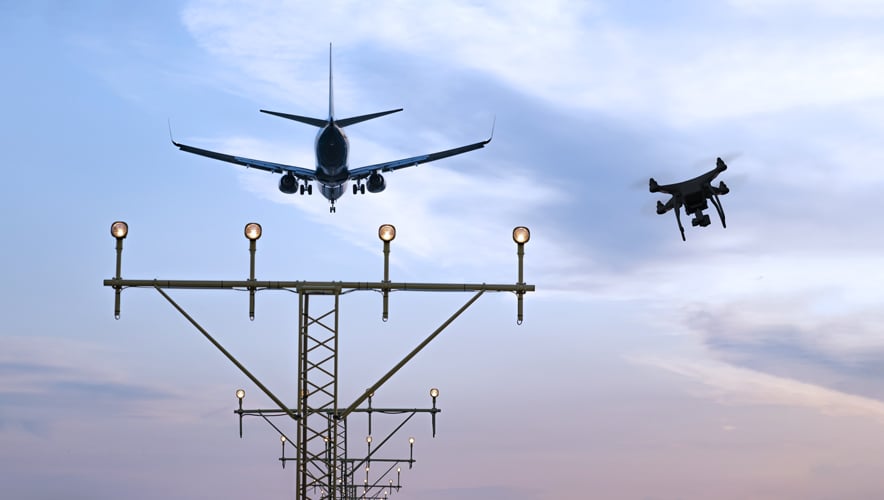Developing Best Practices for Shooting Down Drones
Yemen Houthi rebels launched a drone attack on an oil facility in Abu Dhabi in January 2022, killing three people, exploding several oil tankers, and starting a fire at Abu Dhabi’s nearby international airport.
“Police said preliminary findings indicate there were small flying objects, possibly belonging to drones, that fell in the two areas and may have caused the explosion and fire,” according to the Associated Press. “They said there was no significant damage from the incidents, without offering further details.”
To prevent future attacks, the United Arab Emirates banned flying drones for recreational purposes in the country. The ban joined existing restrictions on flying drones in residential areas and near and around airports, the Associated Press reports.
The January incident highlighted the risk that drones or unmanned aircraft systems (UAS) can pose when laden with explosives, especially if they are able to gain access to secure areas, and the limited options that are sometimes available to intercept them.
Drones contain valuable data which need to be extracted and analyzed to provide evidence to support an investigation.
To help security practitioners assess countermeasures and create best practices for mitigating drone attacks, INTERPOL has been working on a variety of projects that will make resources available to member countries.
For instance, in 2020 the international police organization published the INTERPOL Framework for Responding to a Drone Incident for First Responders and Digital Forensics Specialists as a reference tool for law enforcement. The framework covered the threat of drones, first responder standard operating procedures, and details on the forensic process related to extracting drone data for evidence.
“Drones have become a permanent fixture in the current policing operating environment, and one that can only grow in scale and impact in the future,” according to the framework. “However, many law enforcement officers still lack awareness and understanding of drone technologies. Drones pose a significant threat to public safety and security if abused. It is therefore crucial that officers are equipped with the necessary knowledge and training to respond to drone incidents safely and effectively. Furthermore, drones contain valuable data which need to be extracted and analyzed to provide evidence to support an investigation.”
And in September 2021, INTERPOL partnered with the Norwegian Police to conduct a three-day exercise to evaluate and test drone countermeasures in a security airspace environment at the Oslo Gardermoen Airport.
"The exercise brought together law enforcement, academia, and industry experts from Europe, Israel, and the United States to test and analyze 17 drone countermeasures in an airport environment. The findings will then be adopted into the INTERPOL Drone Countermeasure Framework—available to all 194 INTERPOL member countries and scheduled to be published in 2022.
“Although countermeasures can be used to detect, identify, and locate a drone within an area, many countries do not have the legislation which allows authorities to interfere with a drone when it is in flight,” according to an INTERPOL press release. “This is a huge challenge for law enforcement, governments, and air space owners, pointing to a clear need to improve understanding of drone threats, as well as guidance and reporting mechanisms.”
INTERPOL also joined Project Courageous, an EU-funded initiative that is set to run through 2023. The project explores the assessment, selection, and testing of drone countermeasures for law enforcement.
“Law enforcement officers need to be able to select the appropriate technology to detect, track, and intervene when an illicit drone enters the airspace,” according to an INTERPOL fact sheet. “While a number of commercial solutions are available for these purposes, there is no standardized approach for assessing, testing, and comparing the technology, which makes it difficult for law enforcement to make the most appropriate choice for different policing scenarios.”
There is no standardized approach for assessing, testing, and comparing the technology.
Project Courageous is coordinated by the Belgian Royal Military Academy and includes law enforcement partners from Belgium, Estonia, Greece, Luxembourg, Romania, and Spain. It also has research and technology partners, such as TNO (The Netherlands Organization for applied scientific research), Greece’s Center for Security Studies, Poland’s Military University of Technology, and Spain’s University of Seville.
Together, they will work to develop a standardized methodology for testing and selecting countermeasure systems to detect and track drones that enter protected airspace, for use by stakeholders at prisons, airports, critical infrastructure, and more. The methodology will be validated through trials.
“In the short term, the standardized test methodology will lead to a much better understanding of the capabilities needed to counter UAS among law enforcement agencies, not only among Courageous partners, but also within the European Union network of law enforcement agencies and on a global scale via INTERPOL,” according to the fact sheet. “In the medium-to-long term, a more extensive set of commercial counter-UAS will be tested using the Courageous methodology, which will also allow developers of such systems to make design decisions based upon quantitative data.”
Megan Gates is editor-in-chief of Security Technology. Connect with her at [email protected]. Follow her on Twitter: @mgngates.
